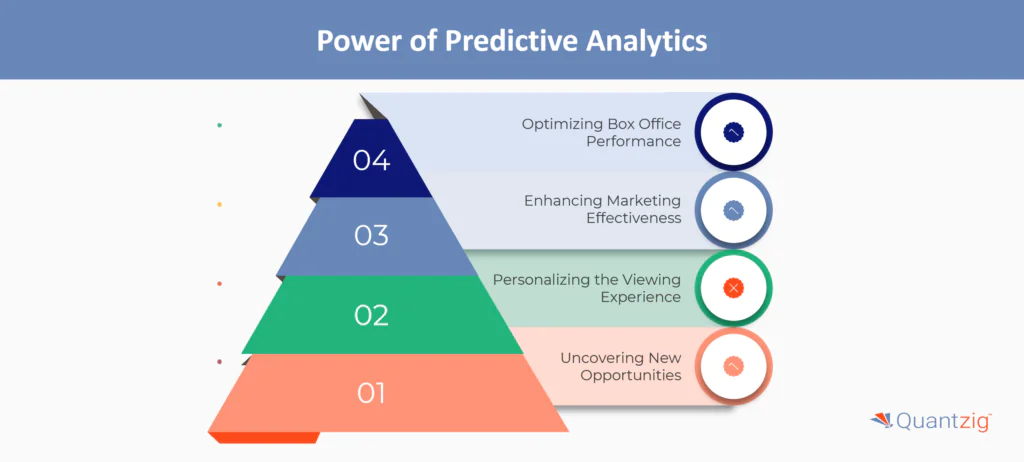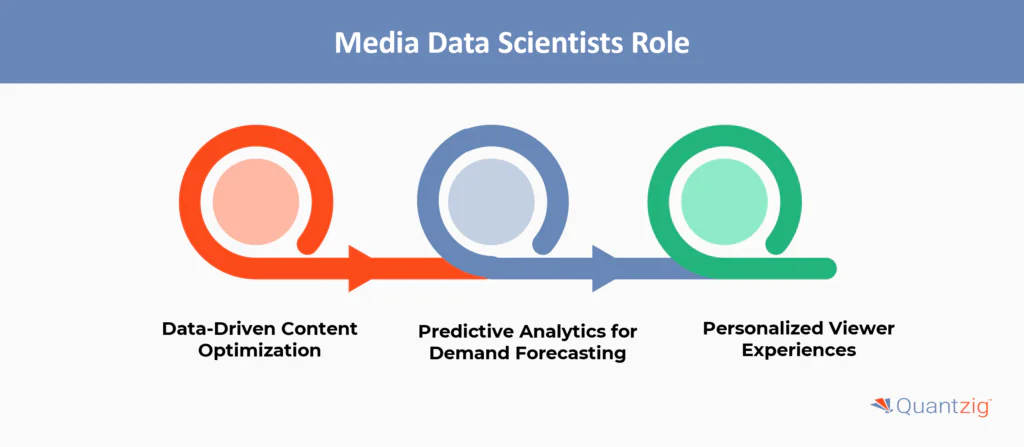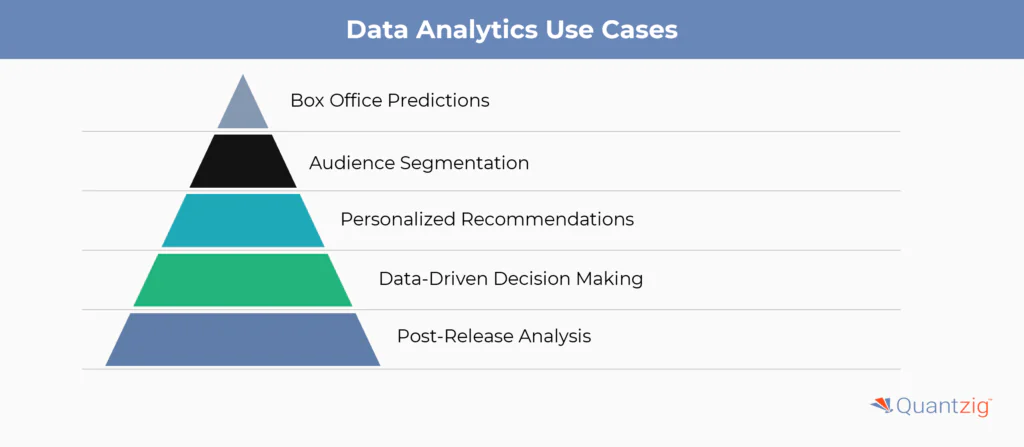Table of Contents
Table of Contents
- Introduction to Predictive Analytics in Movies
- What is Predictive Analytics in Movies?
- Types of Film Audience Data
- The Transformative Power of Predictive Analytics in Movies
- The Symbiotic Relationship Between Big Data Analytics and the Film Industry’s Success
- The Pivotal Role of Media Data Scientists in Shaping Viewer Experiences
- Use Cases of Data Analytics Used in the Movie Industry
- Impact of Real-Time Analytics on Movie Releases
- Predictive Analytics in the Future
- Conclusion
Author: Associate Vice President, Analytics and Data Strategy, Quantzig.
Introduction to Predictive Analytics in Movies
The abundance of content available today can make it challenging for consumers to find the right movies to watch. However, the entertainment industry is leveraging data analytics to better understand audience preferences and deliver more satisfying viewing experiences.
This article explores how data-driven insights on audience behaviors are transforming the Hollywood landscape. By analyzing audience data, industry players are able to optimize marketing campaigns, forecast demand, enhance personalization, and even shape future film productions. These data-driven strategies are enabling the entertainment industry to navigate the evolving media landscape more effectively and provide consumers with content that resonates with their preferences.
Book a demo to experience the meaningful insights we derive from data through our analytical tools and platform capabilities. Schedule a demo today!
Request a Free DemoWhat is Predictive Analytics in Movies?
Predictive Analytics are transforming the entertainment landscape, empowering industry players to better understand audience preferences and optimize the viewing experience. By leveraging advanced analytics, movie studios can gain granular visibility into audience behaviors, enabling more effective marketing strategies and content development decisions.
Types of Film Audience Data
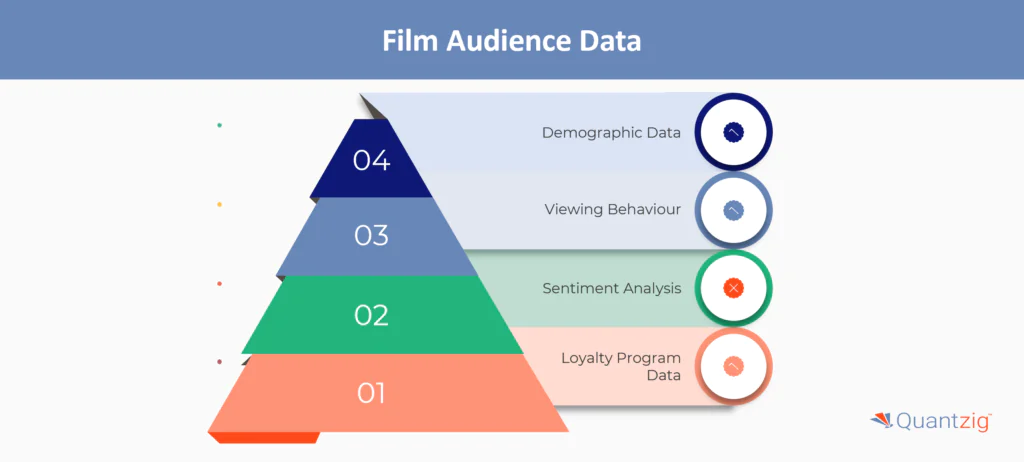
To effectively leverage data analytics, it is crucial to collect and analyze various types of audience data. These data points can be categorized as follows:
1. Demographic Data
Gathering information such as age, gender, location, and socioeconomic status helps identify target audience segments and tailor content and marketing strategies accordingly.
2. Viewing Behavior
Tracking what content audiences consume, how long they engage with it, and across which devices provides valuable insights into their preferences and consumption patterns. This data can inform content development, distribution, and personalization efforts.
3. Sentiment Analysis
Analyzing audience feedback, reviews, and social media mentions allows for a deeper understanding of emotional responses to content. Sentiment analysis enables studios to gauge audience reactions and identify areas for improvement or opportunities for further engagement.
4. Loyalty Program Data
For audiences enrolled in loyalty programs, purchase history and promotional redemption data can reveal valuable insights into spending habits and content preferences. This information can inform personalized recommendations and targeted marketing initiatives.
By collecting and analyzing these diverse data points, entertainment companies can gain a comprehensive understanding of their audience, enabling them to make data-driven decisions that optimize the viewing experience and drive business growth.
The Transformative Power of Predictive Analytics in Movies
Predictive analytics has emerged as a transformative force in the entertainment landscape, empowering movie studios to make more informed, data-driven decisions. By leveraging advanced statistical and data mining techniques, industry players can analyze current and historical data to forecast future outcomes and trends.
1. Optimizing Box Office Performance
One of the key applications of predictive analytics in the film industry is forecasting a movie’s potential box office success. By examining a multitude of factors, such as genre, director, cast, release date, reviews, and social media buzz, studios can develop more accurate projections of a film’s revenue potential. This insight allows them to make strategic decisions around marketing investments and future project development.
2. Enhancing Marketing Effectiveness
Predictive analytics also plays a crucial role in optimizing marketing campaigns. By leveraging granular data on audience demographics and media consumption habits, studios can precisely target their promotional efforts, identifying the most effective platforms, messaging, and trailers to reach their target viewers.
3. Personalizing the Viewing Experience
In the era of streaming, predictive models have become instrumental in delivering personalized content recommendations. By analyzing an individual’s viewing history and preferences, platforms can curate tailored suggestions, leading to higher engagement and customer satisfaction.
4. Uncovering New Opportunities
Beyond these immediate applications, predictive analytics also empowers studios to uncover emerging trends and identify untapped market opportunities. Advanced algorithms can detect patterns in data that may elude human observation, enabling the industry to stay ahead of evolving audience preferences and capitalize on new growth prospects.
As the entertainment landscape continues to evolve, driven by the rise of streaming and social media, the strategic integration of predictive analytics is becoming increasingly crucial for the film industry’s long-term success. By harnessing the power of data-driven insights, studios can make more informed decisions, enhance the viewer experience, and ultimately, strengthen their competitive position in an increasingly dynamic and challenging market.
Data Analytics in Entertainment Industry
Historically, movies have always been about arts; the only data relating to a film would come from box office numbers and ticket sales. It was impossible to predict the success of the movie beforehand, and producers would usually have to rely on their judgment.
However, that’s no more the case today as alternative distribution platforms have given players in the film industry a source to collect data. They have replaced traditional approaches to predicting success through data mining and data analytics. It is not surprising that the film industry is turning toward big data to increase the success rate of their movies.
Leveraging Data Analytics to Predict Box Office Success
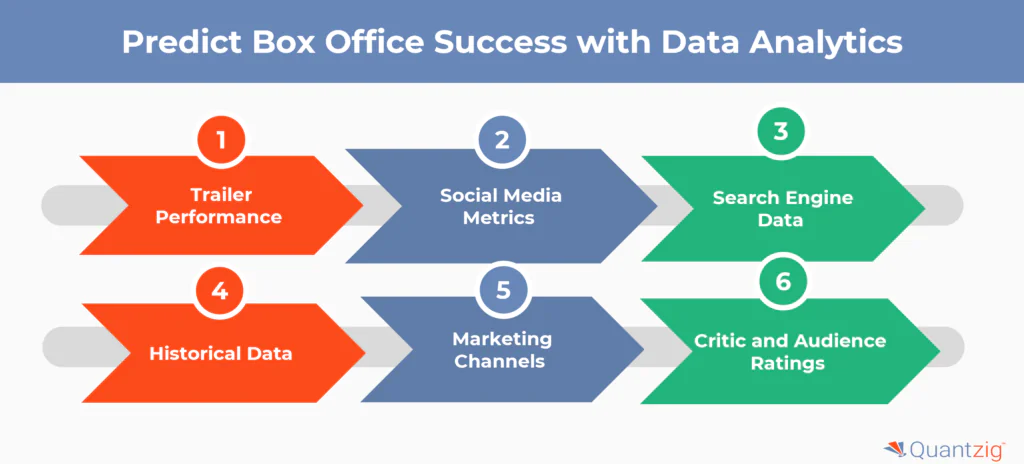
Here are some key data points that can help predict a movie’s success:
1. Trailer Performance
- Trailer views, shares, and engagement on social media platforms
- Positive sentiment and buzz generated by the trailer
- Ability of the trailer to convey the movie’s premise and tone effectively
2. Social Media Metrics
- Organic social media conversations and mentions of the movie
- Trending hashtags and memes related to the movie
- Influencer endorsements and partnerships
3. Search Engine Data
- Search volume and trends for the movie title and related keywords
- Ranking of official movie websites and trailers in search results
4. Historical Data
- Past performance of similar genres, directors, casts, and production companies
- Audience preferences and trends in the target market
5. Marketing Channels
- Effectiveness of various promotional channels like TV, online ads, and experiential events
- Ability to generate viral moments and organic buzz through innovative campaigns
6. Critic and Audience Ratings
- Early critic reviews and scores on aggregator sites
- Audience ratings and word-of-mouth on platforms like Rotten Tomatoes and IMDb
By analyzing these data points, movie studios can gain valuable insights to optimize marketing strategies, forecast demand, and ultimately drive box office success in an increasingly competitive and data-driven entertainment landscape.
Also Read: Track Business Progress with Marketing Analytics Dashboard
Experience the advantages firsthand by testing a customized complimentary pilot designed to address your specific requirements. Pilot studies are non-committal in nature.
Request a Free PilotThe Symbiotic Relationship Between Big Data Analytics and the Film Industry’s Success
1. Audience Insights Fuel Informed Decisions
- Big data analytics provides deep understanding of audience preferences, behaviors, and sentiments
- Granular audience data enables more informed decisions across the film lifecycle
2. Predictive Models Optimize Performance
- Predictive analytics forecasts potential box office performance based on variables like genre, cast, and release date
- Accurate projections help studios allocate resources effectively for marketing, distribution, and future projects
3. Data-Driven Personalization Boosts Engagement
- Personalized content recommendations powered by machine learning algorithms analyze user data
- Tailored suggestions drive increased content consumption and customer loyalty on digital platforms
4. Analytics-Guided Optimization Enhances Experiences
- Data-driven insights enable ongoing optimization of the viewing experience
- A/B testing, real-time performance monitoring, and continuous UI refinement contribute to more satisfying experiences
5. Emerging Trends Uncover New Opportunities
- Advanced analytics detect patterns in audience data that reveal untapped market segments and evolving preferences
- Staying ahead of emerging trends allows studios to capitalize on new growth opportunities
The seamless integration of big data analytics has become a game-changer for the film industry, empowering studios to make more informed decisions, deliver personalized experiences, and ultimately, drive greater commercial success in an increasingly competitive and dynamic market.
The Pivotal Role of Media Data Scientists in Shaping Viewer Experiences
Data scientists in the entertainment industry play a pivotal role in leveraging audience data and advanced analytics to optimize the viewing experience and drive business success. Through their data-driven insights and predictive models, these professionals are shaping the very content and strategies that captivate audiences.
1. Data-Driven Content Optimization
By analyzing vast troves of audience data, media data scientists are empowered to identify the most popular genres, actors, and other content attributes that resonate with their target viewers. This knowledge allows content creators to craft productions that align with audience preferences, optimizing factors such as length, release windows, and marketing channels. Furthermore, data scientists can conduct A/B testing on various creative elements, such as trailers and posters, to continually refine and enhance the content.
2. Predictive Analytics for Demand Forecasting
Leveraging predictive models, media data scientists can analyze a multitude of variables, including genre, cast, director, awards potential, social media engagement, and release date competition, to forecast the potential box office performance of upcoming films. These accurate demand projections empower studios to make informed decisions regarding distribution strategies, production budgets, and marketing investments, ultimately maximizing the profitability of their content.
3. Personalized Viewer Experiences
By delving into audience behavioral data, data scientists in the entertainment industry can develop personalized content recommendation systems that suggest titles tailored to individual preferences. This level of customization not only enhances viewer engagement and satisfaction but also drives increased content consumption, a critical metric for the success of streaming platforms and other digital media outlets.
As the entertainment landscape continues to evolve, driven by the rise of digital platforms and changing viewer habits, the role of media data scientists has become increasingly vital. By leveraging data-driven insights to optimize content, forecast demand, and personalize experiences, these professionals are shaping the future of the industry, ensuring that audiences are captivated and engaged like never before.
Use Cases of Data Analytics in Entertainment Industry
Here are some key use cases of data analytics in entertainment industry:
1. Box Office Predictions
- Predictive models analyze factors like genre, cast, director, awards potential, social media buzz, and early reviews to forecast opening weekend box office revenue
- Accurate demand projections help studios make informed decisions on distribution, marketing budgets, and production investments
2. Audience Segmentation
- Analyzing demographic data, viewing habits, social media interactions, and online behavior enables precise audience segmentation
- Tailoring content and marketing to distinct audience segments ensures offerings resonate with target markets
3. Personalized Recommendations
- Analyzing user behavior, viewing history, ratings, and preferences powers content recommendation systems on streaming platforms
- Personalized recommendations enhance user experience, increase content consumption and retention
4. Data-Driven Decision Making
- Leveraging data insights helps identify emerging trends, assess market demand, and make informed decisions on content creation, distribution, and investment
- Optimizing marketing campaigns, identifying target audiences, and measuring promotional impact
5. Post-Release Analysis
- Sentiment analysis of social media, reviews, and audience polls gauges overall response and pinpoints strengths and weaknesses
- Actionable insights guide iterative improvements for future projects
By harnessing the power of film industry analysis, the movie industry can make more informed decisions, optimize strategies, and create content that resonates with audiences across the entire film lifecycle.
Impact of Real-Time Analytics on Movie Releases
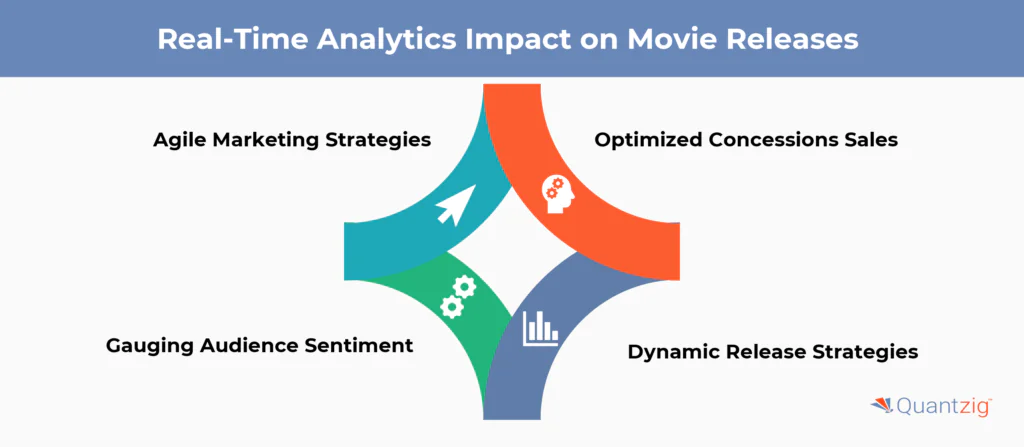
Real-time data analytics is having a significant impact on how movies are released and marketed in today’s digital landscape. Here are some keyways real-time analytics is transforming the movie release process:
1. Agile Marketing Strategies
- Real-time box office data reveals how individual theaters are performing hour-to-hour on opening weekend
- This intelligence allows studios to quickly adapt marketing efforts based on early audience response
- Underperforming theaters may prompt more advertising investment, while strong numbers could lead to expanded releases
2. Optimized Concessions Sales
- Real-time data on concession sales during early screenings shows which items are selling best
- This data informs combo promotions and menu optimizations to drive higher concession revenue
- Theaters can quickly adjust pricing, inventory, and staffing based on real-time sales patterns
3. Gauging Audience Sentiment
- Immediate audience ratings and reviews provide feedback on a movie’s reception once it goes wide
- Negative reviews may prompt re-editing of scenes for subsequent showings
- Positive buzz can inform expanded marketing to capitalize on word-of-mouth
4. Dynamic Release Strategies
- Real-time data allows studios to continuously monitor performance and modify release plans accordingly
- Underperforming films may see release dates adjusted, marketing budgets increased, or wider distribution
- Overperforming movies can be expanded to more theaters to meet demand
In summary, real-time analytics is enabling a more agile, data-driven approach to movie releases. Studios can quickly adapt strategies, optimize operations, and capitalize on audience sentiment to drive better box office results. The days of static, pre-planned rollouts are giving way to dynamic, analytics-guided release strategies.
Also Read: Maximizing Marketing Budgets with Campaign ROI Analysis
Get started with your complimentary trial today and delve into our platform without any obligations. Explore our wide range of customized, consumption driven analytical solutions services built across the analytical maturity levels.
Start your Free Trial TodayPredictive Analytics in the Future
The advancements in data sciences and constant improvement in the movie success algorithms would redefine the way the film industry approaches movie production. In the future, it would be unlikely to see flops denting profits in the quarterly sheets of production houses.
With a wide range of data available for decision-makers in the film industry, the data analytics and prediction models will only get better. As a result, we will see the film industry releasing the movie more systematically with data analytics gaining as much prominence as the director and casts of the movie.
Conclusion
Predictive analytics has become a cornerstone of the entertainment industry, providing invaluable data-driven insights into audience preferences and viewing experiences. By analyzing audience behaviors, demographic data, film industry analysis, movie analytics, and performing sentiment analysis, the film industry can create personalized content and optimize marketing channels. This approach not only enhances the audience’s experience but also ensures competitive advantage and accurate demand forecasting. In an industry marked by fierce competition, leveraging predictive analytics enables production houses to make informed decisions, maximize ROI, and deliver content that resonates with viewers.

